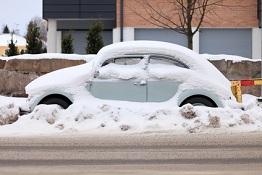 Baby, it’s cold outside.
Baby, it’s cold outside.
But since you really can’t stay, heed some advice before driving in that wintertime snow, sleet and rain.
Last week the Midwest and northeastern U.S. was blanketed with snow and iced with freezing temperatures. Weather forecasts say more is on the way this week, but we all have chores to do, things to eat, people to see. So what are drivers to do when they have to brave the cold?
Things to Remember about Your Insurance
With ice and snow on the roads and reduced visibility come the higher likelihood of getting into an accident and having to file a claim.
As goes with any car accident, it’s important to report the claim as early as possible.
Policyholders should review their policies to see if they will be fully covered if the winter weather calamity strikes.
Comprehensive and collision are two types of optional coverage that encompass most of the crash-related incidents that would occur in wintertime.
“Damage to vehicles from ice or trees is covered under the optional comprehensive coverage in an auto insurance policy,” the Property Casualty Insurers Association of America (PCI) states in a guide to winter driving. “Collision coverage on an auto policy covers crashes in hazardous driving conditions.”
Let’s review two scenarios.
– You park after a hard day’s work. You trudge through the front yard’s snow, get inside, enjoy hot cocoa, unfurl that Snuggie. Then it’s morning, so you head out again to find …
… the biggest branch of the front yard’s elm tree has broken your windshield. Trees, light poles, and other objects weighed down by a night’s worth of snow often fall down, many times on vehicles parked below them. In those cases, comprehensive coverage will pay for the damage.
– You’re driving after a hard day’s work and are about to cross that bridge you’ve crossed a million times. Only this time, the road is icy. Making your way across cautiously, the car still gives way to the slippery road and you can’t keep control as …
… the car hits a bridge’s guard rail and your bumper cracks. Ice, hail, and other wintertime hazards make the road a dangerous place to be. Bad driving conditions often cause accidents, and collision is the go-to type of coverage in those situations whether you slide into a rail, pole or other car.
As optional add-ons, collision and comprehensive don’t come standard with an auto insurance policy, so interested consumers should research how much insurance will cost when extra coverage is added.
Comprehensive coverage also covers a vehicle in situations of theft. The Ohio Insurance Institute advises against the common mistake of leaving your car running in cold weather while waiting for it to heat up; many car thieves use that chance to jump in your vehicle and take off with it.
Was It My Fault?
Not all wintertime accidents are cut-and-dry, so just having the coverage doesn’t guarantee you full compensation for all repairs and injuries if you’re involved in an incident.
Regulators in Oregon provide a handy guide to sorting out coverage implications of weather-related crashes.
In cases where a driver slides into another car, those drivers with collision coverage will likely be reimbursed by their insurer for any damage. If you end up hitting another car, your liability coverage will pay for the other driver’s damages if it ends up being your fault.
According to the Oregon guide, you can still be found at fault if you end up sliding out of control thanks to an icy patch. The crucial factor that helps determine fault is whether the driver was “reasonable and prudent” in his or her actions during such mishaps, according to regulators.
Things to Remember about Your Vehicle
PCI says “old man winter” still packs a mean punch, so make sure your car is up to snuff to withstand the weather. Failing to do so could mean disaster; PCI says wintertime yields more traffic crashes than other times of the year.
Here are some tips for the road when you’re driving on it:
–Defensive driving is even more important in hazardous road conditions (that means always keep a safe distance between you and other cars/objects)
–Check your car for proper levels of: antifreeze, battery power, and windshield wiper fluid
–Check that your car has properly functioning: headlights, taillights, emergency flashers, tires and a battery
–Stock that emergency travel kit with: jumper cables, a shovel, a flashlight, salt, flares
–Stock that emergency survival kit with: blankets, snacks, bottled water, first-aid kit
–Keep at least half a tank of gas in your car at all times
–Shut off cruise control while on slippery roads